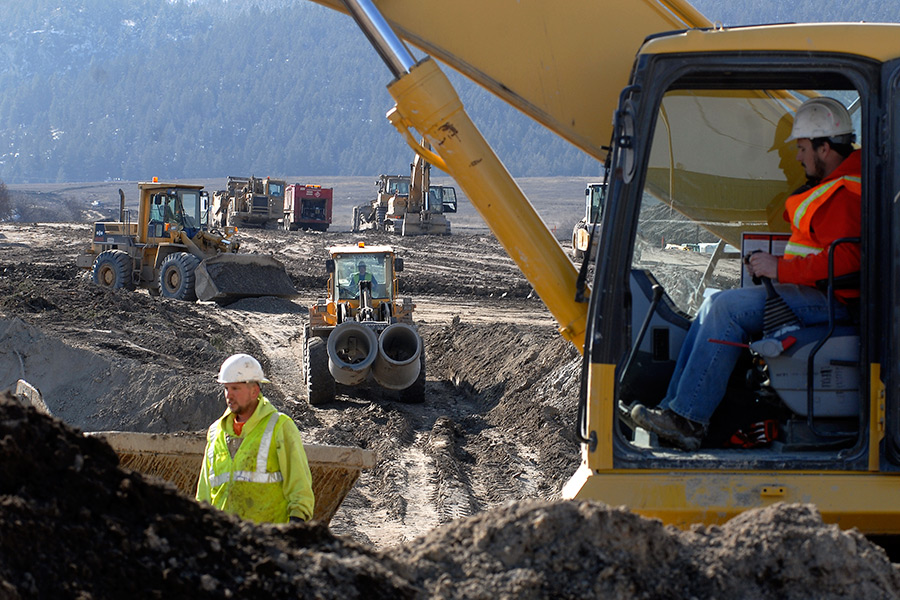Completion of the Kalispell bypass is moving forward following the last-minute Congressional approval of an $8 billion extension of federal transportation funding.
President Obama is expected to sign the short-term extension Thursday, a day before the nation’s road and transit spending expires.
The latest agreement extends funding until Oct. 29. Although it is not the long-term solution that Montana’s delegation and others pushed for, it still allows for Kalispell’s long-awaited bypass to be built over the next year.
“We’ve got the green light,” Jim Mitchell, construction manager for the Montana Department of Transportation, said Thursday.
The state advertised the project July 23 and will begin accepting bids Aug. 27 for the final phase of development, which will include building nearly four miles of new road and pathway, five bridges and a sound wall near Empire Estates subdivision.
A contractor will be selected Sept. 1, and state officials expect work to commence Oct. 12.
The goal is for there to be traffic on the completed bypass by late 2016, Mitchell said.
“We have a pretty aggressive contract timeline set up to encourage them to get in there and get it done,” Mitchell said.
Development was ready to move forward in May but was delayed amid the latest fight in Congress over how to pay for the nation’s multibillion-dollar infrastructure needs.
With a temporary agreement in place, Kalispell’s monumental alternate route is finally fully funded and poised for completion after decades of planning.
The final phase is estimated to cost $35 million, according to MDT.
This last phase will include building a four-lane highway north from the roundabout at Foys Lake Road toward U.S. Highway 2.
A bridge will be built over Ashley Creek and the Rails to Trails path, and another bridge will span U.S. 2. From there the new road will continue north toward Two Mile Drive, where the bypass will run under a new bridge. The road will continue to Three Mile Drive, where a bridge is already in place over the future bypass. The road will go to Four Mile Drive and a new bridge will be built similarly over the bypass. Four Mile Drive will also be completed west to Stillwater Road with a flatter grade. The hill will be reduced by 30 feet. The fifth and final bridge will span Old Reserve Drive near Glacier High School, where the final section of bypass will be connected to current sections.
A sound barrier, similar to the south end, will be constructed along the bypass from Three Mile Drive to Parkridge Drive, near the Empire Estates subdivision.
A pedestrian and bike pathway will trace the entire bypass, similar to the southern portion.
Once the bypass is fully completed, MDT has future plans for expanding the south portion from two lanes to four lanes from the south entrance at U.S. 93 to Foys Lake Road. The immediacy of that project will depend on traffic volumes and funding. The roundabouts at Airport Road and Foys Lake Road would also be replaced with bridges.
Mitchell said the original plans called for the four-lane alternate route and bridges on the south end, but MDT decided to build the current setup because it was cost effective and allowed the project to move forward.
Montana’s Congressional delegation — Sens. Steve Daines and Jon Tester and Rep. Ryan Zinke — sent out statements applauding the passage of the highway funding.
Daines
“Today the Senate took an important step in moving forward a bipartisan, multi-year bill to address our nation’s infrastructure needs. Montanans deserve a long-term solution that provides needed certainty, improves our infrastructure country, and most importantly, helps create jobs.
“I am disappointed that Congress also had to once again pass a short-term extension of the Highway Trust Fund, but I’m thankful that we are engaged in concrete steps to provide the nation with multi-year highway authorization. This vote also secured critical reforms to keep VA hospitals open, give our veterans relief from Obamacare’s employer mandate and expand veterans’ access to the health care services they need. I will continue working to ensure the House and Senate will come to agreement on a multi-year highway bill that provides Montana and our country with the certainty needed to make long-term infrastructure investments.”
Tester
“The Senate just passed a six-year Highway Bill. That is good news for Montana – a state that has 75,000 miles of road. We need to address our infrastructure challenges in a state like Montana where we have $60 billion worth of goods that move over those highways. It is unfortunate that the House did not stick around to give our Department of Transportation, our contractors and the people of Montana the certainty they need to know that we’re going to have a good highway system that supports our economy, not only this year, but well into the future.”
Zinke
“The Highway Bill is one of those ‘must-do’ bills, and I believe infrastructure is a fundamental role of government. Infrastructure is an investment, not simply an expense, that will prepare Montana for the future. A long-term highway bill that is paid for with the right priorities is certainly at the top of my list, but right now Congress has no clear path forward. I am pleased that our Veterans and Highways remain a priority, but I look forward to both Chambers coming together on a fiscally responsible way to build our roads and bridges.”
Corrections (July 31): The original article incorrectly stated that MDT began accepting bids July 23. The agency began advertising the project July 23 and will begin accepting bids Aug. 27. Also, Four Mile Drive will be extended west, not east, to Stillwater Road.
